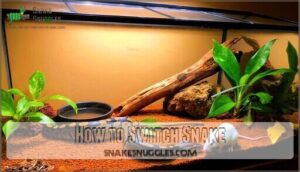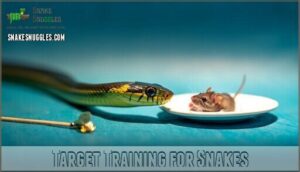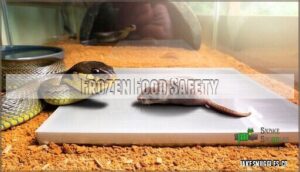This site is supported by our readers. We may earn a commission, at no cost to you, if you purchase through links.

First, thaw frozen rodents completely—8-12 hours in the fridge or 2-4 hours in cold water.
Then warm to 95-100°F using lukewarm water, never a microwave.
Make the prey appealing by wiggling it with feeding tongs to mimic live movement, and consider adding scent enhancers like a drop of tuna juice.
Create a quiet, dimly lit feeding environment and use a gradual shift—start with pre-killed prey before moving to frozen.
Some snakes adapt quickly, while others need weeks of consistent attempts.
The key is maintaining proper prey temperature and natural presentation while staying persistent but never forcing the switch.
Table Of Contents
- Key Takeaways
- Switching to Frozen Food
- How to Switch Snake
- Preparing Frozen Prey
- Enhancing Prey Appeal
- Feeding Techniques
- Transition Strategies
- Overcoming Feeding Challenges
- Snake Health Considerations
- Frozen Food Safety
- Successful Transition Tips
- Frequently Asked Questions (FAQs)
- How to train a snake to eat frozen?
- Is frozen or live better for snakes?
- How do you get rid of snakes?
- How can you turn the snake left?
- What do I do if my snake doesn’t come out?
- How do you keep a ball python safe?
- How do you get a snake to take a bite?
- How do you get a snake to smell a mouse?
- Can you switch a snake from live to frozen?
- How to get your snake to eat frozen?
- Conclusion
Key Takeaways
- Master proper preparation techniques – You’ll need to thaw frozen prey completely (8-12 hours in the fridge), then warm it to 95-100°F using lukewarm water, never a microwave, to ensure your snake finds it appealing.
- Use movement and scent to trigger feeding responses – You should wiggle the prey with feeding tongs to mimic live movement and consider adding scent enhancers, like tuna juice, to make frozen prey irresistible to stubborn eaters.
- Create the right feeding environment – You’ll have better success by providing a quiet, dimly lit space and using a gradual transition approach, starting with pre-killed prey before moving to fully frozen options.
- Practice patience and persistence without forcing – You can’t rush this process, since some snakes adapt quickly, while others need weeks of consistent attempts, but you should never force the switch, as this creates stress and feeding strikes.
Switching to Frozen Food
Switching your snake from live to frozen prey offers significant benefits for both you and your pet.
You’ll reduce the risk of disease transmission while creating a safer feeding environment that eliminates potential injuries from live rodents fighting back, which also creates a safer environment for you.
Benefits of Frozen Prey
When you make the switch to frozen prey, you’re choosing the smarter path for both you and your snake.
Here’s why frozen prey wins hands-down:
- Reduced Parasites – Freezing kills harmful organisms that live prey carries
- Safer Feeding – No risk of bites or scratches to your snake
- Ethical Sourcing – Humane processing without live prey stress
- Cost Savings – Bulk buying frozen is more budget-friendly
- Easy Storage – Convenient freezer storage lasts months
The benefits of frozen prey are clear, offering advantages in safety, ethics, cost, and convenience, making it the preferred choice for snake owners.
Reducing Disease Transmission
Frozen prey acts like a natural shield against disease transmission, protecting your snake from the bacterial concerns and parasite reduction worries that come with live feeding.
Frozen prey eliminates the wild-card risks that come with live feeding
When you choose prekilled rodents from reputable sources, you’re taking preventative measures that matter—source matters tremendously for safe handling.
This simple switch eliminates most health risks, making frozen snake feeding tips your snake’s best friend for long-term wellness.
Increasing Feeding Safety
Live prey poses real risks to your snake’s safety.
Rodents can bite, scratch, or injure your pet during feeding struggles.
Frozen snake feeding eliminates these dangers completely.
Safe snake feeding with frozen rodents means no defensive wounds or stressed encounters.
Your feeding protocols become predictable and controlled.
Proper prey storage and food handling create consistent safety measures, while reptile frozen food removes the unpredictability of live hunting scenarios, ensuring safe snake feeding and proper prey storage.
How to Switch Snake
Transitioning your snake to frozen food isn’t rocket science, but it does require strategy and patience. Think of it like introducing a picky eater to new cuisine—you wouldn’t expect immediate acceptance, right?
The key to successful conversion lies in understanding your snake’s natural instincts and working with them, not against them. Here’s your roadmap:
- Start with pre-killed prey – Fresh-killed rodents bridge the gap between live and frozen food
- Maintain consistent feeding frequency – Don’t skip meals during the conversion period
- Match prey size to your snake species’ requirements exactly
- Create ideal conditions – Proper temperature, humidity, and environmental enrichment reduce stress
Some snakes adapt quickly, while others need weeks or months. Ball pythons, for instance, are notorious for being stubborn about diet changes. Your hydration methods and overall husbandry play vital roles too—a stressed snake won’t embrace new feeding habits.
Remember, this shift benefits both you and your serpentine friend through improved safety and convenience.
Preparing Frozen Prey
Properly preparing frozen prey is vital for successfully switching your snake from live to frozen food.
You’ll need to master three key techniques: thawing the rodent safely, warming it to the right temperature, and using a thermometer to verify accuracy.
This process involves understanding the importance of each step to ensure a smooth transition for your snake.
Thawing Frozen Rodents
When it’s time to start frozen snake feeding, proper thawing becomes your first vital step.
Safe thawing prevents bacterial growth while ensuring your snake gets nutritious meals.
| Thawing Methods | Thawing Time |
|---|---|
| Refrigerator overnight | 8-12 hours |
| Cold water bath | 2-4 hours |
| Lukewarm water | 30-60 minutes |
| Room temperature | 4-6 hours |
| Microwave | Never use |
Always use thawing temperatures between 32-40°F in the fridge, or lukewarm water around 70-80°F for faster results.
Check that frozen food is completely flexible before warming—no ice crystals should remain inside the rodent’s body cavity to ensure a safe meal.
Warming Prey to Room Temperature
Once you’ve thawed your prey completely, warming becomes your next priority.
Gradual warming to ideal warmth (95-100°F) makes all the difference in feeding success.
Submerge sealed prey in warm water for even heating, avoiding overheating that destroys palatability.
Improper thawing can lead to digestive issues for your snake.
Temperature affects scent release and species variation matters—heat-sensing snakes especially need proper warmth for successful adaptation.
Using Thermometers for Accuracy
Accurate temperature readings prevent bacterial growth and guarantee your snake accepts frozen prey.
A reliable thermometer takes the guesswork out of thawing temperatures and heating accuracy, keeping your pet safe during the snake diet switch.
- Digital instant-read thermometers provide quick, precise measurements for temperature consistency during frozen snake feeding preparation.
- Infrared thermometers let you check prey surface temperatures without direct contact, maintaining safe temperatures throughout the thawing process.
- Probe thermometers monitor internal temperatures continuously, guaranteeing feeding techniques meet the 95-100°F target range consistently.
Many reptile owners find a digital temperature gauge helpful for monitoring their reptile’s environment.
Enhancing Prey Appeal
When your snake turns up its nose at frozen prey, you’ll need to make that lifeless rodent irresistible through clever presentation tricks.
The key lies in fooling your snake’s senses into believing they’re getting the real deal, not yesterday’s dinner from the freezer, which requires understanding how to present the prey in a way that mimics live prey.
Mimicking Lifelike Movements
Once your frozen prey reaches ideal temperature, you’ll want to bring it to life with convincing movements. Using feeding tongs, create gentle wiggling motions that mimic a live rodent’s natural behavior.
The tongs technique involves smooth, deliberate movements rather than jerky motions that might startle your snake.
| Movement Type | Technique | Snake Response |
|---|---|---|
| Initial Presentation | Gentle side-to-side wiggling | Curiosity and attention |
| Strike Stimulation | Quick darting movements | Predatory instinct activation |
| Post-Strike | Mimic resistance with light tugging | Enhanced feeding response |
| Overnight Placement | Still positioning in hide | Stress-free feeding opportunity |
After your snake strikes, mimic resistance by providing slight tension through the tongs – this convinces your snake it’s caught live prey. For particularly shy feeders, overnight placement in their favorite hide allows natural feeding behavior without the pressure of your watchful eyes, promoting a stress-free feeding opportunity and enhancing the feeding response with gentle and deliberate movements.
Using Scent Enhancers
Smart snake keepers know scent enhancers can be game-changers for stubborn eaters.
The right scent can turn your pickiest snake into an eager eater overnight
Scent is the secret weapon that turns frozen prey refusers into eager eaters.
Apply commercial enhancers like tuna juice or chicken broth sparingly to the prey’s head—where your snake investigates first. Natural scents work too: rub thawed mice on soiled bedding from live rodent cages for authentic scent transfer.
Remember scent safety: remove enhancers after feeding to prevent overstimulation. It’s also important to keep in mind thawing frozen prey properly for safety.
Preserving Prey Scent
During the thawing process, scent preservation becomes your secret weapon for enticing stubborn eaters.
Thaw prey in sealed bags submerged in warm water—this keeps moisture out while locking natural scents inside.
For scent transfer, briefly touch frozen prey to soiled bedding from live rodent enclosures, letting your snake’s olfactory organ detect familiar aromas.
Cutting prey releases concentrated scents that’ll trigger feeding responses in even the pickiest serpents, utilizing the olfactory organ to detect these aromas.
Feeding Techniques
Once you’ve prepared your frozen prey properly, the way you present it can make or break your snake’s acceptance.
Master these feeding techniques to create positive associations with frozen meals and reduce your snake’s stress during the adaptation process.
Using Feeding Tongs
Feeding tongs become your snake’s dinner bell, signaling mealtime while keeping your hands safe.
Choose long, sturdy tongs with textured grips for secure prey placement and natural mimicry resistance during presentation. Many keepers buy specialized snake tongs for this purpose.
- Tongs Material: Select stainless steel or heat-resistant plastic tongs at least 12 inches long
- Gripping Technique: Hold thawed prey firmly behind the head, avoiding crushing delicate bones
- Prey Placement: Present frozenthawed prey at snake’s eye level, moving slowly toward striking zone
- Mimicry Resistance: Gently tug prey after strike to simulate natural feeding response and encourage swallowing
Target Training for Snakes
Beyond feeding tongs, target stick training teaches your snake to associate specific cues with mealtime.
This positive reinforcement technique uses a small target stick to signal feeding time, helping separate handling from eating.
During snake feeding changeover, consistent target training creates behavioral enrichment that reduces stress.
Your snake learns the target means food’s coming, improving feeding response and making prey presentation more predictable for problem solving feeding issues, which is a result of positive reinforcement and target stick training.
Creating a Quiet Feeding Environment
Your snake’s dining room matters more than you might think.
Reduce stress by creating a secure enclosure with minimal distractions during feeding time.
Cover the habitat with a sheet or use a smaller feeding container for privacy.
Dim the lights and eliminate external stimuli like loud noises or movement.
This observation period allows your snake to focus solely on accepting frozen prey without feeling exposed or threatened.
Transition Strategies
Switching your snake to frozen prey doesn’t have to be an overnight miracle—most snakes need time and patience to accept this change.
The key is using gradual methods that respect your snake’s natural instincts while slowly introducing them to their new dining experience, which requires patience.
Gradual Transition Methods
Patience transforms stubborn feeders into cooperative eaters through systematic steps.
Start with pre-killed introduction using freshly killed, warm prey, then gradually decrease temperature over several feedings.
Document progress while reading hunger cues to time your attempts perfectly, and use scenting and proper thawing techniques throughout the process.
This gradual shift prevents stress-induced feeding strikes, allowing weeks or months for complete frozen food acceptance.
Mixing Live and Frozen Prey
Alternating meals works best when you’re feeling stuck with a stubborn snake. Start by offering live food first, then immediately present frozen food while your snake’s still in hunting mode.
This gradual introduction helps with scent familiarization and hunger levels.
- Watch your snake strike live prey – that hunting instinct stays active for several minutes
- Touch frozen food to live prey – scenting transfers those irresistible smells instantly
- Reduce feeding frequency slightly – hungrier snakes accept frozen food faster during adjustment speed modifications
Monitoring Snake Behavior
Watch your snake closely during feeding attempts to spot key behavioral changes.
Keep a feeding journal tracking strike response, activity levels, and any regurgitation signs.
Notice if your snake shows interest but hesitates, or completely ignores the prey.
Changes in shedding patterns can also affect feeding habits.
Understanding these snake behavior cues helps you adjust your approach and timing for better success by recognizing when your snake is ready to feed, which is crucial for its overall health.
Overcoming Feeding Challenges
Even the most cooperative snake can suddenly turn stubborn when you switch from live to frozen prey, leaving you wondering what went wrong.
Don’t worry—resistance is completely normal, and with the right approach, you’ll overcome these feeding challenges while keeping your snake healthy and stress-free.
Addressing Snake Resistance
When your snake gives you the cold shoulder despite your best efforts, don’t throw in the towel.
Persistent refusal often signals deeper issues requiring scenting strategies or alternate prey types.
Try assist feeding with tongs, but avoid forcing meals—this creates feeding stress.
Stubborn snakes respond better to hunger motivation through patient approach and scenting techniques than aggressive tactics.
Addressing the possibility of underlying health problems is also essential for resolving feeding issues.
Ensuring Optimal Health
Before attempting any feeding changes, check your snake’s overall well-being first.
A healthy snake adapts to frozen food much easier than one battling illness.
Monitor your pet’s weight regularly – sudden drops signal trouble ahead.
Watch for shedding difficulties, which often indicate dehydration or poor health.
Maintain proper hydration by maintaining correct humidity levels.
Schedule veterinary checkups to catch underlying issues early, as parasite prevention keeps your snake in prime condition for successful feeding alterations.
Guarantee proper hydration by maintaining correct humidity levels, ensuring your snake is in good health and ready for feeding changes.
Avoiding Forcing The Transition
Forcing your snake into a frozen food switch creates unnecessary stress and often backfires completely.
Instead, reduce stress through gradual introduction and monitor behavior closely.
If your snake consistently refuses prekilled food, maintain routine consistency while allowing natural hunger to build.
Sometimes stepping back and trying again later works better than pushing forward.
Professional consultation helps when standard gradual adaptation methods fail repeatedly.
Snake Health Considerations
Before you start switching your snake to frozen prey, you’ll want to make sure their overall health and environment are spot-on.
A stressed or sick snake won’t be interested in trying new foods, so getting the basics right first sets you up for success.
Ensuring Proper Enclosure Conditions
Your snake’s enclosure forms the foundation for successful feeding shifts.
Before attempting frozen prey conversion, check that temperature gradients range 75-95°F with proper heating elements.
Maintain humidity levels between 50-60% using appropriate substrate choice and water bowls.
Provide adequate hiding spots on both warm and cool sides.
Enclosure size should allow natural movement – cramped habitats stress snakes and discourage eating, which can be influenced by proper heating elements and temperature gradients.
Addressing Underlying Health Issues
Before addressing health issues, check that your enclosure meets basic requirements.
Hidden health problems often sabotage feeding switches, making your snake resistant to frozen prey when they’d normally accept it willingly.
- Parasite Prevention: Regular fecal exams catch internal parasites before they affect appetite and digestion
- Shedding Problems: Stuck shed around the eyes or mouth creates discomfort that reduces feeding interest
- Respiratory Infections: Wheezing, mouth breathing, or mucus discharge signals illness requiring veterinary care
- Mouth Rot: Red, swollen gums or cheesy discharge prevents comfortable feeding and needs immediate treatment
- Obesity Risks: Overweight snakes become pickier eaters and face serious health complications affecting their wellbeing
Proper temperatures prevent respiratory infection risks.
Maintaining Optimal Temperature and Humidity
Why struggle with feeding issues when proper environmental conditions can make all the difference?
Your snake’s heating gradient should range from basking to cool zones, matching species requirements perfectly.
Maintain humidity levels between 40-60% for most species, using calibrated thermostats for accuracy.
Poor temperature or humidity affects shedding issues, hydration, and appetite.
When thawing prey, consistent husbandry creates ideal feeding conditions that encourage acceptance, leading to better feeding conditions.
Frozen Food Safety
When switching your snake to frozen prey, proper food safety isn’t just about your pet’s health—it’s about creating a clean, contamination-free feeding routine that protects both you and your snake.
Safe handling and storage practices prevent bacterial growth and guarantee your frozen prey remains nutritious and appealing throughout the change process, which is crucial for a contamination-free feeding routine.
Handling and Storage of Frozen Prey
Without proper temperature control, your frozen prey can become a breeding ground for bacteria—yikes!
Keep your freezer between -20°F and 0°F for ideal storage duration.
Use safe handling practices: double-bag prey, rotate stock using first-in-first-out methods, and maintain separate storage from human frozen food.
Proper frozen reptile feeders are essential for safety.
Quality thawing methods prevent prey contamination and preserve nutritional value.
Preventing Contamination
Contamination prevention keeps your snake healthy and your feeding routine safe.
Proper storage practices and safe handling protect both you and your pet from harmful bacteria.
Here are five essential contamination prevention steps:
- Use sealed bags when thawing frozen prey in lukewarm water to prevent bacterial infiltration
- Ensure water quality by using clean, fresh water for all thawing methods
- Follow refrigerator storage practices by keeping frozen prey separate from human food
- Practice safe handling with clean hands and sanitized tongs during preparation
- Monitor thawing methods to avoid temperature danger zones that promote bacterial growth
These frozen snake care basics prevent health risks while maintaining nutritional value. Clean storage practices create a safer feeding environment for your reptile companion.
Maintaining a Clean Feeding Environment
Clean feeding areas protect your snake’s health by reducing Bacteria Control risks and preventing illness.
Remove waste from the feeding enclosure immediately after meals to avoid attracting pests. Disinfect Surfaces weekly with reptile-safe cleaners, focusing on feeding spots.
Replace Safe Bedding regularly to prevent accidental bedding consumption during frozen snake feeding sessions. Monitor Water Quality if bowls are present, changing water after messy meals.
A spotless enclosure keeps your slithery friend happy and healthy.
Successful Transition Tips
Successfully switching your snake to frozen prey requires three key elements: patience, careful record-keeping, and flexibility in your approach.
Think of it like teaching someone a new skill—some snakes catch on quickly, while others need weeks or even months to make the change, and that’s completely normal.
Practicing Patience and Persistence
Rome wasn’t built in a day, and your snake won’t switch overnight either.
Avoid forcing the change—stress creates feeding strikes and health issues.
Instead, embrace gradual introduction with routine consistency. Some snakes need weeks or months to accept new preferences and abandon old habits.
Monitor weight regularly while maintaining persistence through multiple attempts.
A gradual shift requires patience, but consistency wins.
Documenting Feeding Attempts
Track every feeding attempt like a scientist studying behavior. Create a feeding journal recording dates, prey temperature, your snake’s response, and refusal reasons.
Weight monitoring helps identify patterns – maybe your snake accepts frozen food better after skipping meals. Behavior analysis reveals preferences for specific prey sizes or presentation methods.
Pattern identification guides success strategies moving forward. To maintain hygiene, sanitize feeding equipment regularly, which is crucial for healthy feeding and prey presentation.
Adjusting Transition Methods as Needed
Your feeding log becomes your roadmap when standard methods aren’t working.
Watch for behavioral cues like tongue flicking or defensive posturing to gauge your snake’s response. Monitor weight weekly during the snake feeding shift to confirm health isn’t compromised.
- Switch prey types – Try different colors, sizes, or brands if your snake keeps refusing
- Modify warming techniques – Some snakes prefer cooler prey around 85°F instead of body temperature
- Change feeding schedules – Nocturnal species might need evening feeds, not afternoon attempts
- Adjust scenting methods – Alternate between chicken broth, fish oil, or soiled bedding from live prey
- Seek professional consultation – A reptile vet can rule out health issues affecting appetite
Remember, routine consistency matters more than perfection. If alternative prey or gradual shift adjustments aren’t successful after several weeks, don’t force it – your snake’s telling you something important.
Frequently Asked Questions (FAQs)
How to train a snake to eat frozen?
Convincing your slithery roommate that frozen dinners aren’t beneath their standards?
Warm prey to 95-100°F, wiggle with tongs to mimic movement, and enhance scent with chicken broth.
Patience wins—some snakes need weeks to accept this culinary compromise.
This approach requires patience and understanding of the snake’s behavior and preferences.
Is frozen or live better for snakes?
Frozen prey’s your safer bet—it eliminates disease risks, parasites, and bite injuries while being more convenient and cost-effective than live rodents for most snake species.
How do you get rid of snakes?
Picture rustling grass as unwelcome serpents slither through your yard—you’ll need strategic removal methods.
Remove shelter like wood piles, seal entry points, use commercial repellents, or contact wildlife professionals for safe, humane relocation.
How can you turn the snake left?
You can’t physically "turn" a snake left like steering a car. Snakes move independently and follow their own instincts, heat sources, or scent trails to navigate their environment naturally.
What do I do if my snake doesn’t come out?
Your snake’s become an absolute hermit! Don’t panic—snakes often hide when stressed, shedding, or simply feeling secure.
Check your temperatures and humidity first. If they’re correct, leave your snake alone for a few days.
They’ll emerge when hungry or ready, which is a completely normal behavior for snakes, especially when they are feeling secure.
How do you keep a ball python safe?
You’ll keep your ball python healthy by maintaining proper temperatures (78-80°F cool side, 88-92°F warm side).
Humidity around 50-60%, secure enclosure with tight-fitting lid, and appropriate hides are also essential.
Regular vet checkups are necessary to ensure the health of your ball python.
How do you get a snake to take a bite?
Warm your frozen prey to 95-100°F, then wiggle it with tongs to mimic live movement. This "zombie dance" triggers hunting instincts and encourages striking behavior effectively.
How do you get a snake to smell a mouse?
Snakes detect prey scent through their forked tongues, which sample air molecules 10,000 times more effectively than human noses.
You’ll enhance scent by warming frozen mice to 95-100°F using warm water, which releases natural odors that trigger your snake’s feeding response.
Can you switch a snake from live to frozen?
Yes, you can switch your snake from live to frozen prey with patience and proper technique.
Start by offering freshly-killed warm rodents, then gradually introduce frozen-thawed prey heated to 95-100°F, using gentle wiggling motions to simulate movement.
How to get your snake to eat frozen?
Transforming your serpent into a frozen-food enthusiast requires patience and clever tricks.
Warm prey to 95-100°F, wiggle with tongs to mimic life, and try scent enhancers like chicken broth for stubborn eaters.
Conclusion
Like switching from telegraph to telephone, learning how to switch snake to frozen prey requires patience and persistence.
Your snake’s changeover depends on consistent technique—proper thawing, ideal warming to 95-100°F, and natural presentation with feeding tongs.
Don’t rush the process; some snakes adapt within days while others need weeks.
Remember, you’re not just changing their diet—you’re improving their safety and your convenience.
Stay patient, maintain proper temperatures, and trust that most snakes will eventually accept frozen prey when presented correctly.
- https://wheremyscalesslither.weebly.com/switching-your-snake-to-frozen-prey.html
- https://regardingreptiles.com/22-tips-to-get-a-snake-to-eat-frozen-food/
- https://www.zenhabitats.com/blogs/reptile-care-sheets-resources/switching-your-snake-from-live-prey-to-frozen-thawed-how-to-switch-your-snake-from-live-to-frozen-thawed-tips-and-tricks
- https://www.reddit.com/r/snakes/comments/7lkhcc/my_fool_proof_method_of_switching_from_live_to/
- https://www.thebreedinglab.com/properly-thaw-a-rodent



















